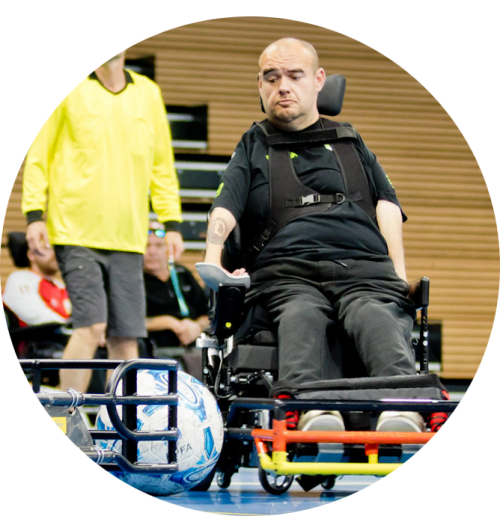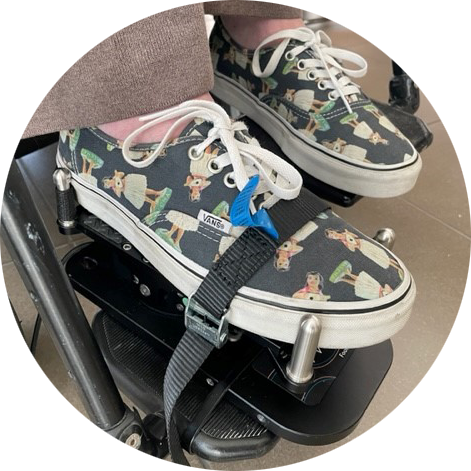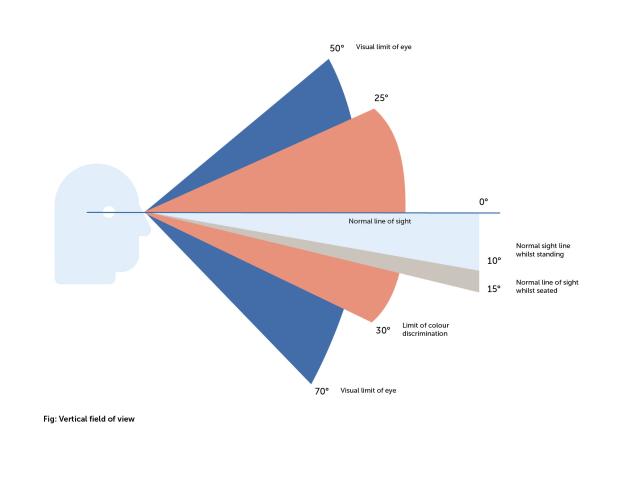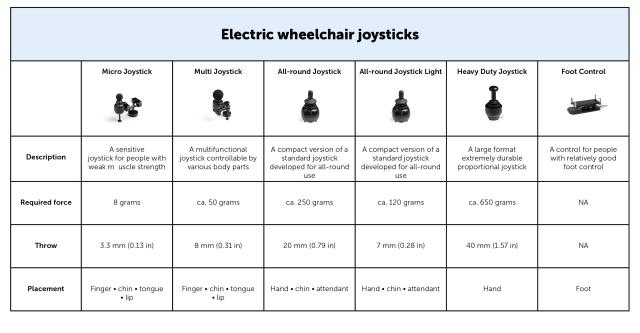Part 3 ● Applying different drive control solutions to complex mobility problems
In part 2 of this blog series, we handed you a framework to use during the selection process of a drive control. By using five different building blocks, the framework helps you answer the question ‘What is needed to control an electric wheelchair?’ We briefly talked about the placement of a drive control and the required force to operate it.
In this part we talk about the importance of vision, core stability, and muscle function. Three factors to take into account when evaluating drive control placement. Furthermore, we look at anatomical sites of the body suitable to operate a drive control. Finally, we compare existing wheelchair joysticks and illustrate a few real-life cases.
Determining drive control placement
Remember ‘Approach’, building block three of our framework? It is about optimally placing the drive control on the electric wheelchair. Three different factors determine whether a user can reach and use a control comfortably. These factors are vision, core stability, and joint flexion or extension.
Vision
It might be very obvious but – in general - you need good eyesight for safe power wheelchair mobility. This is needed to spot the control system, navigate your surroundings safely and judge distances. When using a hand control, you need control over your head to move your visual field towards your hand.
Our analytical visual field is the 10-15° above and below the horizontal visual field. You have to be able to place the joystick within this field. Outside of this field, only movements and colours can be detected.
This means that driving with your foot, for example, is harder than driving with your hand, as it is very difficult or impossible to get your foot within your analytical visual field. The learning process is bigger and there is little visual information.
Core stability
As described by Lange & Minkel (2018), power mobility systems are intended to provide function and mobility, but without stability, there can be no function. You can have the best drive control, with the best programming, but that cannot substitute for incorrect seating and positioning. So that is a very important prerequisite.
Core stability is connected to optimal seating. Core stability is the ability to maintain a stable and balanced position during movement and activities. You can help clients obtain a good core stability with postural management and seating adaptations.
Without core stability controlled movements are difficult. A seating cushion, for example, provides pelvic stability. Lateral support creates even more core stability since it stabilizes the shoulder joint.
Muscle function
Using you muscles sounds like an easy task but for people with complex mobility problems, it isn’t. You need (some) muscle function to approach the control system. In other words, the ability to flex your shoulder and to extend your wrist and elbow in case of a traditional hand joystick.
To determine which control can be reached by the user, you need a muscle function assessment. Furthermore, the user must have repeatable reliable upper extremity control and not just at the moment of assessment. Related to muscle function are the different anatomical sites of our body suitable to operate a drive control.
Evaluating different anatomical sites
To use a drive control comfortably, you need to determine with the user which anatomical site is preferred. An anatomical site of the body is capable of performing a variety of movements or actions, which make it possible for the user to operate the electric wheelchair. Because a relatively fine control is required, you must identify the body area that gives the most consistent access for independent control.
Hands and fingers are the preferred anatomical site because we typically use our hands or fingers for manipulative tasks. You can have a hand joystick at the distal position or at a more medial position in front of the user. In that case, you will need some hardware options (e.g. adaptation to place a standard control in a table).
Placing a joystick more medial is favorable for some people, as it is more intuitive to use both hands, cognitively less demanding and it limits the degrees of freedom needed at the shoulder and elbow. Furthermore, when the hand function is limited, adaptations of the joystick handles can help as well.
If fine motor control limitations prevent the use of hands or fingers, the use of the head as an anatomical site for a drive control is also an option. You can obtain a relatively precise control using head movements such as tilting side to side or a forward and backward movement. The control interface isn’t limited to the traditional head control, which is located at the back of the head, but is also applicable for the chin, if that is preferred.
Another anatomical site - not used very frequently - is a foot. Driving an electrical wheelchair by foot is less desirable because you cannot get the control within the line of sight and foot control is generally not as fine as hand control.
On the other hand, driving a foot control feels intuitive since it resembles a gas pedal. Some individuals are able to develop fine control in their feet or muscle function remains longer possible in that specific location (e.g. some people with ALS).
Comparing different wheelchair joysticks
Simultaneously with assessing the placement and anatomical site, you look at the strength of the user. As we mentioned in part 2, there is a whole range of joysticks available on the market. Either for people with reduced muscle strength and movements and for people with very spastic movements.
Besides the strength required for the joystick, there is also some additional programming that you can do to make it easier for the user. There are parameters that you can set in the electronics of the wheelchair itself (such as throw, sensitivity, etc.), but others can be set in the controls themselves.
With the framework in the back of your mind, we now look at some real-life examples of drive control applications. We have selected a few examples of drive control applications. The examples are based on people with various complex mobility problems, ranging from a limited muscle strength to excessive force.
Real-life examples of drive control applications
A very small proportional joystick
If someone heavily relies on the remaining little finger strength, a small and sensitive joystick can help that person enjoy an independent life again.
The Micro Joystick is specifically designed for people with very poor or weak muscle strength and/or limited movements. It can easily be controlled by different body parts e.g. finger, chin, tongue, lip and is recommended for people with muscular or neuromuscular diseases.
The story of Ben
Spinal Muscular Atrophy, SMA in short, strongly affects muscle strength and dexterity. Ben, who has SMA, relies heavily on the little strength that’s left in his index finger. Amongst other assistive devices, he uses the ultra-sensitive Micro Joystick Omni (5 gr adapted) to enjoy a more social and independent life. He experiences this joystick as easy to use. According to him, it’s light enough for someone with limited force and at the same time guarantees a comfortable driving experience.

Adaptations to a joystick handle
Even if the hand function is limited, the drive control can accommodate for limitations in fine motor control. This can be done with joystick handle adaptations. A differently shaped joystick handle can make a difference in which muscles, extensors and flexors are used.
In case of a progressive muscle disease, try to take the evolution of the disease into account when selecting a drive control and its topper.
The story of Torsten
Torsten is a Powerchair Football player who has excessive force and cannot operate his fingers separately. He controls the durable hand joystick with his entire arm via an adjusted joystick handle. The joystick handle is a custom-made hand shell that fits his whole hand. With 3D printing on the rise, custom-made options for joystick handles are growing.

An intuitive foot control
As mentioned above, a foot can also be used to drive an electric wheelchair. This is a good solution when hand and fingers muscles are no longer functioning and when head movements are difficult.
The Foot Control is designed for people with hand or arm function problems and a relatively good foot control (e.g. some people with ALS or Cerebral Palsy). With this control, movements of the foot can be converted into steering and control of the wheelchair.
The story of Sophie
Sophie has a rare case of Ehlers-Danlos syndrome. She is an active user of the Micro Joystick for over ten years. This is a sensitive joystick, which she operates with one finger. Since Sophie is advocating for awareness of assistive devices, she was keen to give the Foot Control a try as she has quite good control in her legs and feet. Without any practice she could control her wheelchair with her foot, which was really surprising to her. This goes to show, that it might be worth considering some lesser-known options as well in the selection process.

Enablers for chin control
When the preferred anatomical site is the chin, you have different options. For example, a chin control harness or a motorized swing away arm.
The benefit of a harness is that it moves along with the user during the day. If the body positioning changes, the control remains in front of the chin. Furthermore, it’s easy to remove the control from the harness, for example, when eating.
Another option for a chin control is a motorized arm. An arm like this can move away horizontally or vertically. A correct installation is crucial in this case. You want as little movements of the arm as possible to ensure a stable driving position. The advantage of an arm like this is more independence for the user, who can decide to move the joystick away from the face.
Higher quality of life and independence
This is just a selection of real-life examples of how different drive controls can be applied. With these examples, we have come to an end of this blog series. The goal of this blog series is to hand you not only the theoretical background but also a practical framework to formalize how you select a drive control for an electric wheelchair user.
Earlier published parts of this blog series:
-
Part 1 ● The importance of differentiating between standard and special drive controls
-
Part 2 ● A comprehensive framework to assess drive control needs
After reading this blog series, we truly hope to convince you of working thoroughly when selecting a drive control for an electric wheelchair user. In the end, the right drive control translates into a higher quality of life and more independence for the wheelchair user. Something extremely valuable if you ask us.
In need of more information about a specific drive control? Contact us.
Sources
- Lange & Minkel, 2018, Seating and Wheeled Mobility: A Clinical Resource Guide, Thorofare, NJ: Slack Inc., ISBN: 971-1-63091-396-0
- Vercaemer et al., 2017, Clinical Guide to Powerchair Provision, Invacare N.V.

